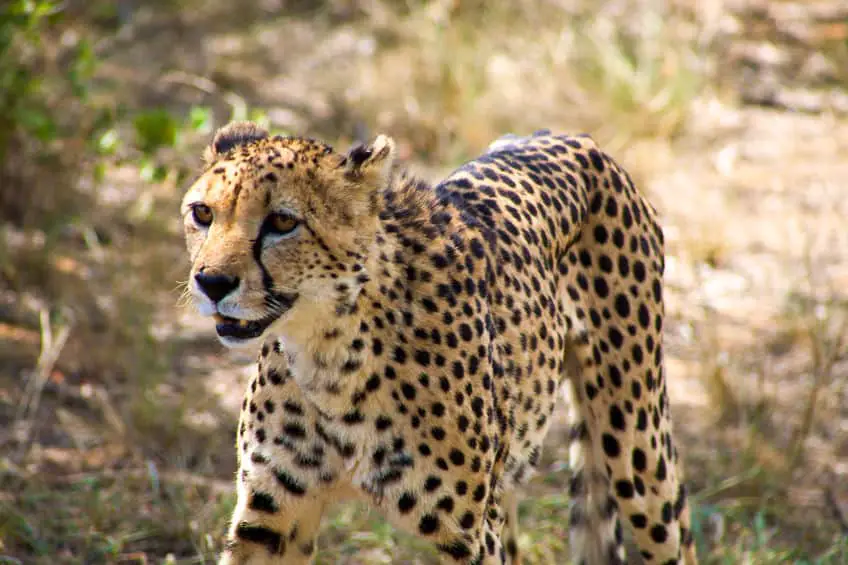
Unlike the other big cats of Africa that are nocturnal, cheetahs are diurnal which means that they are active and hunt during the day. But why exactly is it that cheetahs are not nocturnal like the other big cats? I have answered that question in this post.
Why are cheetahs not nocturnal? By being diurnal, cheetahs can avoid most competition from larger and stronger predators who are usually active at night. Additionally, cheetahs are diurnal because they need good light conditions for their hunts which takes place at very high speeds.
Below I have described what type of competition cheetahs avoid by being diurnal and exactly why they are so dependent on good light conditions for hunting when other big African cats are not.
Less Competition From Predators
Being diurnal is a rare trait in cats so this makes the cheetah very unique.
One of the primary reasons why cheetahs are not nocturnal unlike most other large African predators or scavengers is to avoid or at least reduce, competition from larger ones who can easily steal the cheetahs’ kills as they are much larger and stronger.
Cheetahs rely heavily on speed and maneuverability when hunting which makes them stand out from the other big cats of Africa quite a bit.
Both leopards and lions rely heavily on stealth and strength as their hunting success is determined by their ability to sneak up behind prey animals and get as close as possible before finally leaping for the kill.
Cheetahs utilize their ability to reach incredibly high speeds when they hunt as well as their ability to take quick, sharp turns and maneuver extremely efficiently at those high speeds.
Cheetahs can reach top speeds of close to 70 miles per hour (around 110 kilometers per hour) which is much higher than any of the other big cats. Or any other land-living creature for that matter.
The cheetah is the land-living animal that can reach the highest top speed on the entire planet.
Being the fastest land-living animal in the world does come at a cost, however, as cheetahs are not nearly as strong as many other large African predators which means that cheetahs would almost always lose in a potential conflict.
To overcome this threat, however, cheetahs are simply active and hunt when the competition is not.
More specifically, most of the large African predators that can pose a threat to cheetahs including spotted hyenas, lions, leopards, and sometimes jackals are all primarily nocturnal. Of course, conflicts do happen but being diurnal reduces the risk for cheetahs significantly.
Especially spotted hyenas can cause trouble for cheetahs and it is not uncommon to see a cackle of spotted hyenas (a group of hyenas is called a cackle) try to move in on a cheetah or a small coalition (group) of cheetahs who are eating to steal their kill.
The other two big cats of Africa, leopards, and lions to be specific are also a common threat to cheetahs and will also often steal prey from cheetahs when given the chance.
I found this incredible footage where you can see just how intense it can get when cheetahs have to protect their food.
At the beginning of the footage, a group of jackals are trying to get a taste of the cheetahs’ kill but are too small and too few to stand any real chance against the cheetahs, but as you will see, things can change quickly and dramatically when a larger predator shows up.
Cheetahs are very aware that they cannot compete with larger predators and as can be seen in the footage above, they will scatter as soon as a leopard shows up.
Avoiding competition from larger predators is a big reason why cheetahs are not nocturnal but it is not the only reason. Their hunting style makes them depend heavily on good light conditions which are only found during the day and primarily in the morning and late afternoon.
High-speed Hunting Requires Good Light
As I have already stated, cheetahs are the fastest land-living animal in the world. They reach incredible speeds of 70 mph (around 110 km/h) when hunting. They can accelerate extremely fast and go from 0 to 60 mph (0-96 km/h) in just three seconds and on top of this, they can take incredibly fast and sharp turns at those high speeds.
Another important reason why cheetahs are diurnal and not nocturnal is that hunting at such extreme speeds requires proper light conditions which are just not found during the night.
The fact that they are the fastest land-living animal is no accident. Cheetahs are built for speed.
They have a perfectly aerodynamic body with a small head and no unnecessary weight anywhere on them.
Unlike other cats, cheetahs also have non-retractable claws. This allows for extra traction and grip when accelerating and taking sharp turns at the high speeds that they can reach.
Where leopards and lions rely on stealth to sneak up behind their target prey and get as close as possible (often within just 15 feet or 5 meters) before they strike, cheetahs can initiate a chase when they are much further away as they will quickly catch up to their target.
Cheetahs quickly overheat when they run as fast as they do and their hunts will often be made up of short bursts of incredible speed rather than long chases. A chase usually lasts for about 20 seconds after which the cheetah will need to rest for a bit before it is ready for another chase.
Since cheetahs overheat rather quickly, their hunting usually takes place in the morning or the late afternoon and they usually spend the warmest and brightest hours of the day resting.
Cheetahs are incredible hunters and have a much higher success rate than both leopards and lions. In some areas of Africa, cheetahs have a hunting success rate of over 50%.
When a cheetah has caught up to a target, the cheetah will often use its non-retractable claws to make the prey animal trip and fall, paralyzing it briefly which is when the cheetah will kill it.
Cheetahs primarily hunt in big, wide, open, and flat fields and savannas or grasslands with some small hills or elevated points from which they can sit and scout the area.
Cheetahs Hunting at Night
Cheetahs hunt almost exclusively during the day but they have actually also been observed hunting at night and especially during a full moon as this can also illuminate an area and make it possible for the cheetahs to see and hunt.
Hunting at night is, however, a very risky thing to do for cheetahs as this is when their primary natural enemies such as spotted hyenas, leopards, and lions are active.

